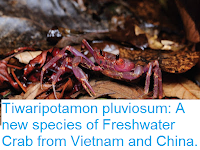The Western Ghats of southwestern India are considered to be a biodiversity hotspot, with a high number of endemic (not found anywhere else) species of animals and plants. A wide range of groups of organisms have been studied in this area, including freshwater Crabs, many species of which have been described from the Western Ghats in recent years, though to date no Crabs from other environments have been described from this region.
In a paper published in the Journal of Crustacean Biology on 3 April 2017, Appukuttannair Biju Kumar and Smrithy Raj of the Department of Aquatic Biology and Fisheries at the University of Kerala and Peter Ng of the Lee Kong Chian Natural History Museum at the National University of Singapore, describe a tree-dwelling Crab from the Kottoor Reserve Forest in the Western Ghats of Kerala State in southwest India.
The new species is named Kani maranjandu, where ‘Kani’ honours the Kanikkaran or Kani people of Kerala, who live in the area where the Crabs were found and helped in the collection of specimens, and ‘maranjandu’ means ‘Tree-Crab’ in Malayalam. The Crabs are oval in shape with long legs, bluish-black in colour with an orange underside. The largest male found measured 42.6 x 30.8 mm while the largest female was 40.6 x 30.44 mm.
Kani maranjandu,
specimen on tree trunk. Sali Palode in Kumar et al. (2017).
The Crabs were found living only
in trees with flooded bowls, they were found in a variety of trees, including
Bedda Nut Tree, Terminalia bellirica, Flowering Murdah, Terminalia paniculata, Malabar
Ironwood, Hopea parviflora, True Cinnamon Tree, Cinnamomum verum, and Evergreen
Tropical Blackboard Tree, Alstonia scholaris. They were found in trees with
bowls at a range of heights, from close to the ground to about 10 m up, and
were observed consuming leaves, seeds and invertebrates. They were found in
degraded forests close to settlements within the Kottoor Reserve Forest, part
of the Agasthyamala Biological Park.
(A) Degraded forest
area near the tribal settlement at Agathyamala Biological Park, Kottoor Reserve
Forest, Kottoor, Kerala, India, where specimens of Kani maranjandu were found;
(B) tree fork of Terminalia paniculata; (C) phytotelm in tree fork of
Terminalia paniculata; (D) male specimen (33.1 × 24.3 mm) of Kani maranjandu
collected from inside a phytotelm in a tree fork of Terminalia paniculata; (E)
tree hollow of Cinnamomum verum, where individuals of the new species may live;
(F), (G) when approached by members of the Kani tribe, the Crabs climb up the
trunk of Cinnamomum verum, the tribesmen then cut a series of holes in trees to
climb up after them. Kumar et al. (2017).
See also...
Follow Sciency Thoughts on Facebook.








